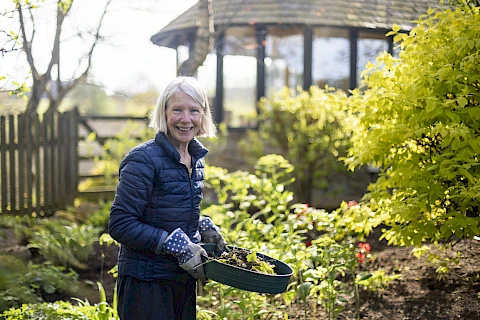
Gardening can be a delightful hobby for seniors, providing both physical exercise and mental stimulation. One important task for garden enthusiasts is ensuring the survival of bulb plants during the winter months. Properly storing bulbs can guarantee a vibrant garden come spring. Senior Helpers Akron-Summit will walk through each step of how to dig up and safely store bulbs for the winter, specifically for seniors and their caretakers.
When to Dig Up Your Bulbs
In the Akron-Summit area, the best time to start digging up bulbs is after the first frost but before the ground freezes solid. This typically falls between late October and early November. Look for signs that the bulbs are ready: leaves will begin to yellow and die back naturally. This indicates that the bulb has stored enough energy for the winter.
Preparing Bulbs for Storage
Preparing to dig up bulbs requires some basic tools and precautions to ensure the safety of the gardener and the plants. Seniors will need a garden fork or shovel, pruning shears, gloves, and a soft brush.
Begin by gently loosening the soil around the bulb with a garden fork or shovel and avoid piercing the bulb. Lift the bulb from the ground, supporting it from underneath. Then, trim the remaining foliage to about an inch above the bulb with pruning shears.
For a safe gardening experience, seniors should use tools with ergonomic handles to reduce strain on their hands and wrists. They can wear gloves to protect their hands from dirt and potential cuts. They should also take frequent breaks to avoid overexertion.
Cleaning and Drying Bulbs
Once the bulbs are out of the ground, cleaning and drying them properly is essential to prevent mold and rot. Gently brush off excess soil using a soft brush and avoid using water as moisture can cause rot. Lay out bulbs in a single layer in a well-ventilated area, keeping them out of direct sunlight. Allow bulbs to dry for one to two weeks. The skins should feel papery once they are dried thoroughly.
Proper storage conditions can make all the difference when replanting successfully in the spring. Maintain a temperature between 35-50°F and ensure low humidity to keep the bulbs dry. Use mesh bags, paper bags, or trays with good air circulation for storage. Avoid plastic bags, as they can trap moisture and lead to rot. Clearly label each bag or tray with the bulb type and other pertinent information. This helps to keep things organized and makes gardening easier for seniors.
Replanting Bulbs in Spring
When the warmer days of spring arrive, it's time to replant the bulbs seniors have carefully stored over the winter. Replant bulbs in late March to early April, once the danger of frost has passed. Plant bulbs at a depth of about three times the height of the bulb, spacing them according to the package instructions to ensure they have room to grow. Don't forget to water newly planted bulbs thoroughly to help them settle in. To maintain bulb plants, keep soil moist but not waterlogged, and fertilize occasionally for strong growth.
Let Us Help With Seniors' Gardening Tasks
Storing bulb plants for winter may seem complicated, but the right steps can make the process more manageable. Remember to dig up bulbs after the first frost, clean and dry them properly, and store them in a cool, dry place.
Replant them in the spring for a beautiful garden. Gardening is a fulfilling activity that seniors can enjoy with minimal risk, especially with help from family members or caregivers. For more assistance with gardening and other senior care needs in Akron, Medina, Wadsworth, Barberton, and Summit County, contact us at Senior Helpers Akron-Summit.